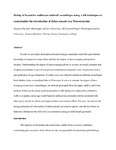Dating of Lacustrine molluscan Subfossil Assemblages Using AAR Techniques to Contextualize the Introduction of Zebra Mussels to a Wisconsin Lake

View/
Author
Bua-Iam, Sequoya A.
Subject
Washington and Lee University -- Senior Thesis in Geology
Introduced organisms
Wisconsin -- Shadow Lake
Zebra mussel -- Research
Metadata
Show full item recordDescription
Sequoya Bua-Iam is a member of the Class of 2017 of Washington and Lee University. Thesis; [FULL-TEXT FREELY AVAILABLE ONLINE] In order to accurately track paleoecological change, researchers must first gain detailed knowledge of respective sample dates and thus the degree of time-averaging among those samples. Understanding the degree of time-averaging allows us to more accurately interpret data on paleocommunities as part of a larger environmental investigation. Here, we present a source and application of age estimations of surface and core-collected molluscan subfossil assemblages from Shadow Lake, a remediated lake in Wisconsin. In order to estimate the degree of time-averaging in our core’s assemblages, we selected gastropods from the upper, middle, and lower sections of the core for amino acid racemization (AAR) dating with radiocarbon calibration. AAR is complete, and an age model based on radiocarbon calibration will be correlated with other proxy records to inform and improve future conservation efforts. For now, we estimate the timing and means of introduction of zebra mussels, an invasive species, into the lake based on historical information but will verify our estimations using an AAR-based age model. Sequoya Bua-Iam